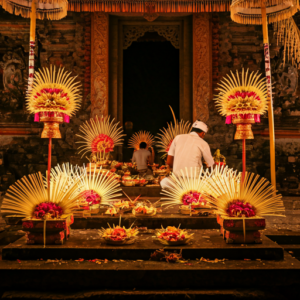
Canang Sari holds a special place in Balinese culture and spirituality. These small, square or round palm-leaf baskets filled with colorful flowers are daily offerings found in front of houses, shops, and temples across Bali. Let’s delve into the significance and philosophy behind Canang Sari:
- Symbol of Thankfulness: The phrase Canang Sari is derived from Balinese words: “sari” (essence) and “canang” (a small palm-leaf basket). These offerings symbolize gratitude and thankfulness to the Hindu god, Ida Sang Hyang Widhi Wasa, for the peace bestowed upon the world.
- Colorful Flowers and Their Meanings:
- White Flowers (Iswara): Pointing east, they symbolize Iswara, one of the primary forms of God (also known as Shiva or Mahadeva).
- Red Flowers (Brahma): Pointing south, they represent Brahma, the progenitor or great grandsire of all human beings.
- Yellow Flowers (Mahadeva): Pointing west, they signify Mahadeva (meaning “Great god”), associated with Shiva.
- Blue or Green Flowers (Vishnu): Pointing north, they symbolize Vishnu, the preserver within the Hindu Trinity.
- Placement and Purpose:
- Specific Spots: Each Canang Sari is placed at specific spots around the home, including wells, entrances, fires, granaries, crops, livestock, and altars.
- Essentials of Life: These offerings appreciate the essentials of life that we rely on daily.
- Environmental Philosophy: Hinduism in Bali emphasizes the relationship between humanity and the environment. Whatever comes from nature must return to nature.
- Ritual and Removal:
- Daily Offering: Canang Sari is offered every day as a form of gratitude.
- One-Night Stay: Normally, it remains for one night after being prayed and offered before being replaced with a new one.
In summary, Canang Sari reflects the deep spiritual connection between the Balinese people and their land, honoring the divine and maintaining balance in the universe. 🌿🙏🏼





